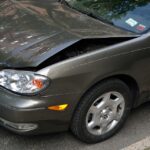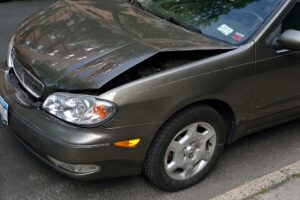
Car Insurance & Road Rage
 Courtesy of iii.org
Courtesy of iii.org
Road rage incidents are not only dangerous, they are exempted from coverage by many auto insurance policies. Understand your risks and take precautionary measures to avoid being a victim—or a cause—of aggressive driving accidents.
Crowded highways and traffic backups at times cause drivers to lose control and become extremely aggressive. Road rage is a real problem that can lead to serious accidents or even incidents of violence on the road.
It's important to realize that road rage is listed as an exemption in many auto insurance policies. This is because any damage or liability stemming from aggressive driving isn't considered an accident but rather as having been caused by risky behavior.
Rather than risk paying the consequences of road rage—one of which may be not having your auto insurance claim paid—it's best to avoid a dangerous and costly aggressive driving incident in the first place.
If you encounter an aggressive driver on the road…
- Stay as far away as possible. Slow down or change lanes if need be, let the driver pass you and give yourself room at intersections to drive away.
- Record a description of the car and note the license plate number if possible so that you can report him or her to the police for the sake of everyone's safety.
- Do not engage with or challenge the offender in any way. Ignore the driver's rudeness and don't give into the temptation to react in kind or you might escalate the risky behavior.
- Put your safety first. If an aggressive driver starts to follow you, keep your doors locked, and head to the nearest police station. Never stop and confront an aggressive driver.
If you have a short fuse yourself stay cool and…
- Leave plenty of time to get where you need to go. When you're in a hurry, your patience is short and you are much more likely to become aggravated.
- Remember other drivers are not annoying you on purpose. People make mistakes or they might be driving more slowly for a reason—they might be lost, or their sight might be impaired by sun glare.
- Don't use hand—or single finger—gestures other than a wave to someone who lets you into your lane.
- Don't tailgate slow drivers. Hanging on another car's back bumper is dangerous. If the car in front of you has to stop short and you rear-end it, the accident would be considered your fault.
- Don't honk your horn insistently. Leaning on your horn is a bad practice. While it might make you feel better to express your frustration in a traffic jam, it won't make anyone go any faster, it's annoying to other drivers and passengers and it increases everyone’s stress level, which may lead to more aggressive behavior.
- Never stop to confront another driver. It could lead to a dangerous situation for all concerned.

Nice Gifts-Be Sure to Protect Them Today!
 Courtesy of iii.org
Courtesy of iii.org
The holidays are a time of giving and receiving gifts, but would you be able to replace those gifts if they were destroyed in a fire or other disaster? A home inventory is the best way to protect your personal possessions, yet only 50 percent of homeowners said they had an inventory in a 2016 Insurance Information Institute (I.I.I.) survey. That’s where Know Your Stuff®, the free, award-winning home inventory app can help.
The I.I.I.’s Know Your Stuff® home inventory app allows you to enter information on mobile or desktop and syncs across all your devices so you can access it anywhere, at any time. It can help you:
- Purchase enough insurance to replace the items you own, if they are stolen or damaged.
- Get insurance claims settled faster.
- Substantiate losses or charitable donations for tax purposes.
- Keep track of items that require maintenance or repair.
- Declutter and organize your home.
“With the average property damage and liability claim costing more than $9,000 and about one in 15 insured homes having a claim each year, it’s important for homeowners to protect their assets,” said Loretta Worters, a vice president with the I.I.I. “Renters should also consider taking a home inventory.”
To simplify the task of creating an inventory, the Know Your Stuff® app allows you to take photographs of your possessions and organize them according to the room in which the items are located.
With the Know Your Stuff® Home Inventory app, you get:
- Secure free cloud storage of your inventory data. You can also store and manage all your insurance policy information, including contact information for your insurance professional and your policy numbers.
- Downloadable reports for easy recordkeeping and claims filing.
- A tool that is backed by the expertise of the I.I.I., a leading independent insurance research and communications organization.
Know Your Stuff® also allows you to keep track of multiple properties and insurance policies. An opt-in service provides integrated weather alerts for your area as well as updates and tips on how to prepare your home against severe weather.

Help on Protecting Your Business From Bad Weather Effects
 Courtesy of iii.org
Courtesy of iii.org
Courtesy of iii.org
With predictions of an above-average hurricane season issued by Colorado State University this week, businesses need to take measures to prepare and increase their chance of surviving, according to the Insurance Information Institute (I.I.I.).
Forty percent of businesses do not reopen after a disaster and another 25 percent fail within one year, according to the Federal Emergency Management Agency (FEMA). But by taking action now to prepare, businesses can increase their chance of getting back on their feet financially and keeping their doors open.
The I.I.I. and the Insurance Institute for Business & Home Safety (IBHS) recommend the following steps:
Develop a Business Continuity Plan
Having a business continuity plan is vital for companies to prepare for, survive and recover from a hurricane. Use IBHS free OFB-EZ (Open for Business) business continuity planning tool to create a plan that focuses on recovering after the initial emergency response. Share your plan with employees, assign responsibilities and offer training so your workforce can collaborate in the recovery of your business. Conduct regular drills to assess and improve response.
Maintain Key Information Offsite
To get your business up and operating as quickly as possible after a disaster, you'll need to be able to access critical business information. In addition to backing up computer data, keep other critical information offsite such as your insurance policies, banking information and phone numbers of employees, key customers, vendors and suppliers, your insurance professional and others. If you have a back-up site, make sure it's sufficiently far away so as not to be affected by the same risks that threaten the primary location. Use IBHS free EZ-PREPTM severe weather emergency preparedness and response planning toolkit with checklists that can be customized for your company to be sure you have a well-organized plan and are ready to respond when disasters occur.
Create a Business Inventory
Include all business equipment, supplies and merchandise and don't forget commercial vehicles.
Review Your Insurance Coverage
The time to review your insurance policy is before disaster strikes and you have to file a claim. It is important that your business have both the right amount and type of insurance for its needs and risk profile. There are two types of policies you can buy as a business owner:
A Business Owner Policy (BOP) is commonly used by small businesses. BOP policies combine property and liability coverage in one policy and are usually less comprehensive than a commercial policy.
A Commercial Multi-peril (CMP) policy combines several coverages such as commercial property, liability, inland marine and commercial auto into a single policy. It is typically less expensive to buy a CMP policy than to buy the coverages individually.
Opt for Replacement Cost Coverage
Most commercial property policies provide either replacement cost coverage, actual cash value coverage, or a combination of both. Replacement cost coverage will pay to rebuild or repair property, based on current construction costs. Actual cash value coverage will pay to rebuild or replace the property minus depreciation. Depreciation is a decrease in value due to wear and tear or age. If your business is destroyed and you only have actual cash value coverage, you may not be in a position to completely rebuild.
Consider Tenant Coverage
If you rent or lease a building, consider tenant coverage, which will insure your on-premises property, including machinery, furniture and merchandise. The building owner's policy will not cover your contents.
Don't Forget About Flood Insurance
Flooding is not covered by standard commercial insurance policies, so consider buying a separate flood policy. If you're located in a high- to moderate-risk flood zone, you could be protecting your business from devastating financial loss. Commercial flood coverage is available from the National Flood Insurance Program (NFIP) and provides up to $500,000 in building coverage and $500,000 for contents. You can also get coverage through private insurers.
Visit the Business Insurance section of the I.I.I. website for more information.
RELATED LINKS
Facts and Statistics: Catastrophes
Articles: When Disaster Strikes: Preparation, Response and Recovery; Does My Business Need Flood Insurance?
SOURCES:
Insurance Institute for Business & Home Safety
National Flood Insurance Program